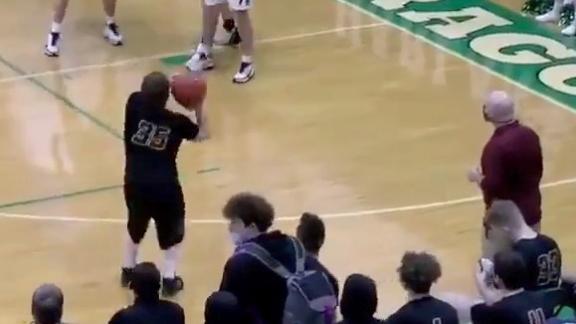Full disclosure before we begin: The first time I heard about the "Courses of Interest" for Stanford athletes was Wednesday, when about 50 Facebook friends posted it on my wall and had a good laugh at my expense.
It didn't exist when I played softball for Stanford from 1997-2001, but I did take five of the courses on list and I'm pretty sure I got either an A or a B in all of them because I got an A or a B in every class I took at Stanford.
What struck me most about the list though, was how few of the classes that were actually considered "easy" are on the list. Every college has them. They pick up fun names like "Quakes for Flakes" [Geology] or "Wish Upon a Star" [Astronomy] or "Mummies for Dummies" [Anthropology].
A lot of athletes take them to fulfill science requirements. But so do a lot of English majors.
At Stanford we called them "fuzzy classes" and no one needed a list to know which ones they were. If anything, fuzzy classes were more popular among the pre-law crowd than the athletes. No use ruining that perfect GPA and sparkling LSAT score over an upper-division computer science class. Plus, the Sweet Hall computer lab always smelled funky during midterms and finals week when all the CS and EE majors camped out for a week at a time to finish their programs.
I had a lot of reactions to the "Courses of Interest" list when I heard about it Wednesday. Mostly it just made me kind of sad because of the impression it gave about Stanford athletes.
I'm not going to tell you that every Stanford athlete can compete academically with non-athletes. I won't even argue every Stanford athlete would've been admitted to the school if they didn't play a sport really, really well.
The one thing I can say with conviction and certainty though is that no athlete goes to Stanford looking for easy A's.
Why would they?
If you're good enough to play a Division I sport at Stanford it's a fair bet you had several other offers at schools with less rigorous academic demands and admission policies.
I chose Stanford over UC Berkeley, Harvard, Yale, UCLA, UC San Diego, UC Santa Barbara and Michigan.
Like every athlete who chooses Stanford, the academic rigor was a selling point for me, not an issue to work around.
Did playing a sport affect my academic performance? Of course. We practiced every day from 2-6 p.m. and it was strongly encouraged that we take morning classes. Over the years, that ruled out a handful of classes I would've wanted to take. But since I can't remember the names of any of those classes anymore, it obviously didn't affect me all that much.
The real sacrifices I had to make in the course of being an athlete came with extracurricular activities. Research projects I didn't have time to join, study abroad I didn't want to miss a season for, office hours with professors I skipped in favor of a nap.
I regret some of those choices now. But I also treasure my experience as a student-athlete, so it's hard to say whether I'd really change things if I could go back to that time in my life.
I took my classes and softball very seriously. There wasn't room for much else. Dating was like another five-unit class. Frat parties and drinking would just make me throw-up at practice the next day.
In other words, I was pretty focused. Which is generally what Stanford looks for when admitting athletes.
There are no official standards you have to hit to get in. No magic formula of SAT scores and GPA, although generally it's gotta be above 1150 (out of 1600) and 3.5. But it's a sliding scale. And yes, it varies by sport.
A football player with a 1100 SAT and 3.4 GPA might get in while a softball player with the same scores wouldn't.
If one was more important than the other, it was GPA. That might seem strange at first. Like what if you went to an easy high school or took a bunch of junior college classes to inflate your GPA?
But if you think about it a little, it makes perfect sense. GPA is generally a good measure effort and focus, while SAT scores are a pretty good predictor of intelligence and potential.
I don't want to put words in the admissions counselors mouths, but my theory was always that Stanford realized an athlete who has shown a willingness to work in high school would do the same in college, even if the material was more difficult. They'd fight through it, seek out tutoring or counseling, and do what they needed to to succeed.
What I always found so interesting was how voluntary all that tutoring was. My freshman year I was supposed to meet in a study group with other athletes, but most of us found it wasn't all that productive and we could just study with other people -- regular students -- on our own time.
From the very beginning, Stanford integrates its athletes into the general population. An athlete is assigned a freshman roommate just like every other student. The only difference is that Stanford makes sure an athlete rooms with a non-athlete.
That's not a coincidence. Stanford doesn't want there to be a wide gap or a de facto segregation of athletes from the general student body. It's for the benefit of the athlete as much as the non-athlete, because each group can learn quite a bit from the other.
People often ask whether everyone at Stanford was really smart. My answer is always the same.
Five or 10 percent of the students there were simply geniuses. Off-the-charts, rocket-scientist geniuses. Another five or 10 percent were not that bright. Or maybe they were just shy, it was hard to tell.
Everyone else worked really hard, and was excellent at something. For some it was chemistry or computer science, for others it was volleyball.
But all of us snagged a few easy-A's along the way.
Ramona Shelburne is a columnist for ESPNLosAngeles.com and was a four-time Academic All-American at Stanford.




